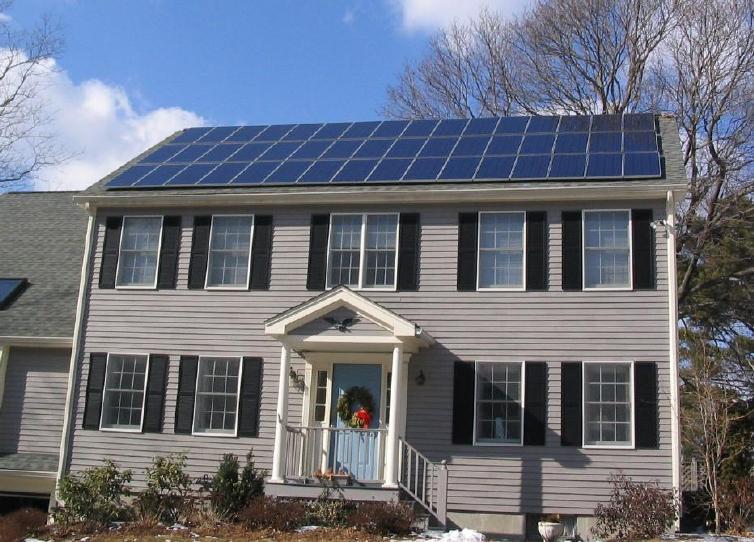Solar powered homes
Interview with
Although the materials our homes are built from might be taking inspiration from the past, the way we power them certainly isn't. Solar power, known as photovoltaics - PV - is showing enormous promise, as Connie Orbach heard from Oxford University's Henry Snaith...
the past, the way we power them certainly isn't. Solar power, known as photovoltaics - PV - is showing enormous promise, as Connie Orbach heard from Oxford University's Henry Snaith...
Henry - Most solar panels are made out of a material called silicon, which is a semiconductor; it's the same material we use in our computers. It absorbs sunlight and from that sunlight it generates electricity. The silicon was quite expensive but it's been scaled industrially over the last ten years especially and now it's actually not very expensive. This means that solar power is almost as inexpensive to make electricity as conventional power like coal and gas and, of course, this depends where in the world you are and how much sunlight you have.
Connie - That's quite surprising, I didn't realise we were quite as close as that but they're not ideal yet are they because they're not particularly efficient?
Henry - No. I guess it depends on what scale you look but the efficiency of a module we measure it as an efficiency of converting solar energy into electric energy and they are typically around 20%. And that probably sounds like that's not very efficient, you've got 80% left that you could get but, actually, 20% is still quite good but we can do better. There is a way of making solar cells more efficient and that's a type of device called a multijunction device.
Connie - Silicon is a single junction device meaning it only absorbs certain parts of the Sun's energy but, if you have lots of different junctions in the solar cells, each one can collect a different part of the light like ultraviolet or infrared, therefore increasing the amount of sunlight you can make use of. In fact, for a multijunction device, we can get up to 50% efficiency...
Henry - Fortuitously, about four years ago we discovered that a new family of materials called perovskites could work very, very well in solar cells and these materials are based on salts that mix together and form a crystalline compound very similar, for instance, to just table salt that dissolves in water. When it dries it crystallizes to form little crystals and it appears to have all the good properties of these very high quality semiconductors, despite being very easy to process.
Connie - Well that sounds great. Why are we still messing around with these old fashioned ones then - what's going on?
Henry - OK. All new technologies take a fairly long time to work through all the problems to get them to fulfill their promise. So, as I said, we discovered these perovskites worked well about four years ago and, since then, there's been an absolute explosion in research interest. There's been increasing commercial development in getting these technologies to the level that they can outperform current technologies and then enter the market. So we want to be able to do it within the next two to five years but there are a number of challenges that still remain. The promise is all there, but we have to deliver now by making sure these materials and the solar cells will last for 25 years, making sure they outperform silicon not just on small cells, but also on large areas. Massed produced every day all the modules have to be very high efficiency. There's also a drive towards being able to make these solar cells look like glazing so that you can have tinted windows and be able to generate a fair amount of power off them whilst also being able to see through.
Connie - And can perovskites deal with that?
Henry - Perovskites can be coated directly onto glass; they make what we call a thin film module so perovskites can, basically, look like a sheet of glazing.
Connie - Thinking about timescale, what are we thinking for our house in 2050? Is it going to be powered off solar?
Henry - It has every possibility of being powered off solar. The technology will definitely be there to do that. The balance is really the cost differential between producing your electricity in a field and then just using conventional transmission to transmit the power to the building versus the benefit of producing the power locally on the building. And combining that with the aesthetics, the stuff to really make a really big impact on buildings, it has to be versatile because architects are rather pernickety about what a building looks like....
Connie - It's not like it's their job!
Henry - Maybe fortunately or unfortunately, exactly. So we have to develop technologies that are versatile and then, I think, we will see a situation in the future where any free space which is exposed to sunlight will be generating power.
Connie - And in terms of price, we're expecting that to come down a lot as well?
Henry - If I had to make a prediction, I'd say in 15 years time, probably PV anywhere in the world with storage will be cheaper than any other technology for producing power.
- Previous Alternative building materials
- Next Sustainable housing in action









Comments
Add a comment